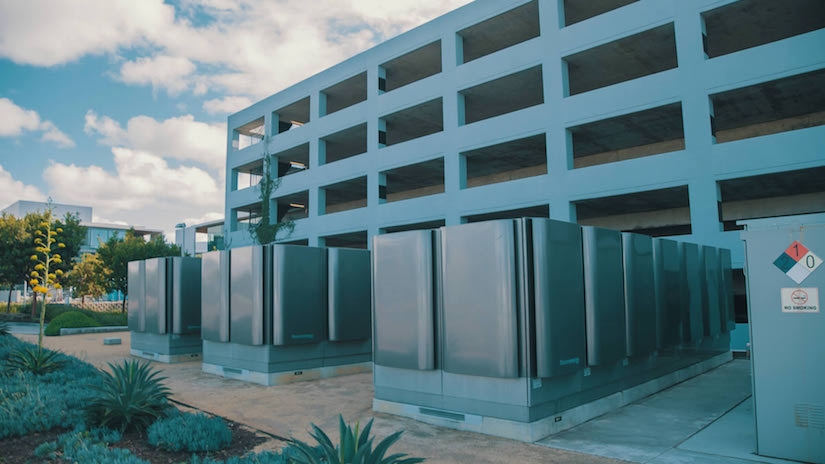Apr 10 2019
Solid oxide fuel cells, a potential replacement to traditional power plants, use electrochemical techniques that can produce power more efficiently when compared to combustion-based generators that are currently in use.
 Solid oxide fuel cells can be used in a variety of applications, including efficiently generating primary or emergency backup power for buildings. A group of Bloom Energy Servers generates power using solid oxide fuel cells. (Image credit: Bloom Energy)
Solid oxide fuel cells can be used in a variety of applications, including efficiently generating primary or emergency backup power for buildings. A group of Bloom Energy Servers generates power using solid oxide fuel cells. (Image credit: Bloom Energy)
However, fuel cells tend to deteriorate very rapidly, masking any efficiency gains through higher costs.
At present, in a development that could help open the door to longer-lived green energy devices, engineers at the University of Wisconsin–Madison have provided new insights into the chemical reactions that enable fuel cells.
Fuel cells are exciting technologies with potentially disruptive capabilities. But degradation issues have been a major obstacle for the consumer market.
Dane Morgan, Professor, Materials Science and Engineering, UW–Madison
Dane Morgan was the lead author of the study. He and his associates recently reported their findings in the Nature Communications journal.
One reason due to which fuel cells deteriorate is the very high temperatures, above 1500 ○F, at which the devices must operate to power the chemical reactions that generate electricity.
In fuel cells, oxygen is mixed with an external fuel source, a process equivalent to the heat and light-yielding transformation that happens in fire. However, fuel cells carry out those chemical reactions without burning. Hence, fuel cells can produce energy with considerably more efficiency when compared to combustion.
Rather, fuel cells function like batteries to some extent, comprising of two electrodes isolated by an electrolyte, which is a material that carries ions. One of the electrodes splits oxygen gas from the air into individual atoms, which can subsequently be carried and mixed with fuel. Importantly, splitting oxygen frees up electrons that can move through a circuit as current to power homes or devices. This oxygen-splitting occurs at a component known as the cathode.
However, oxygen gas is quite stable and hence it cannot be split easily. Furthermore, attempts to drive the reactions efficiently at lower temperatures with compatible materials have been difficult, partly as scientists actually are not aware of the atomic scale details of the chemical reactions that occur at the cathode.
Previously, researchers really didn’t understand what the rate-limiting steps are for how oxygen comes onto a surface, splits and enters a material.
Yipeng Cao, Study Lead Student, UW–Madison
The gas molecule must split into two atoms, only then oxygen can enter the cathode. Next, each atom must come across a structure referred to as a vacancy, which is a small molecular gap at the surface of the material that enables oxygen to enter. Gaining insights into this process is hard since it takes place at the top atomic layers of the cathode, whose chemistry can be relatively different from the bulk of the material.
“Measuring composition and vacancy chemistry at those top two layers is extremely challenging,” states Morgan.
Therefore, Morgan and his colleagues opted for computer simulations. As leading experts in molecular modeling, they integrated density functional theory with kinetic modeling to obtain atomic-level insight into the reactions happening on the top two layers of the cathode.
The group found out that splitting is not the rate-limiting step in the investigated material. They identified that the manner in which oxygen atoms find and enter vacancies at the surface is decreasing fuel cell efficiency.
Thus, a material with more vacancies could possibly make fuel cells much more efficient.
“This could allow for materials design in a way that was very hard to do before,” reports Morgan.
The scientists directed their focus toward one specific material, a model compound for several common fuel cell cathodes known as lanthanum strontium cobaltate. They are aiming to expand the analysis to involve other materials shortly.
The discoveries could have an effect beyond fuel cells as well. There are a number of applications for materials that exchange oxygen with the environment, for example, CO2 reduction, water splitting, gas separation, and electronic components known as memristors.
I think we have a much better handle on how to control the oxygen exchange process. It’s early, but this could open the door to a broadly applicable design strategy for controlling oxygen exchange.
Dane Morgan, Professor, Materials Science and Engineering, UW–Madison
This study was supported by grants from the U.S. Department of Energy (DESC0001284) and National Science Foundation (OCI-1053575).